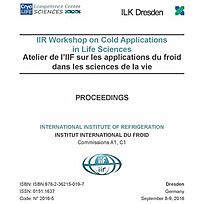
Document IIF
Stratégies servant à concevoir des échafaudages bi-couches à l'usage de la médecine régénérative et du génie tissulaire.
Strategies for the design of bi-layer scaffolds for the regenerative medicine and tissue engineering.
Numéro : pap. 025
Auteurs : REINSCH H., KRETSCHMER R., HEIDINGSFELDER J.
Résumé
In the field of regenerative medicine and tissue engineering 3-dimensional collagen scaffolds play an important role to guide the formation of functional novel tissue structures. Thereby, different cell types often have to be separated for a defined period of time to generate multilayer tissue structures like skin or to control cell migration in the process of tissue regeneration. Such applications require heterogeneous scaffold structures with a bi-layer structure. Such scaffolds can decelerate or prevent cell migration by a barrier of compacted material. Additionally they may provide different pore sizes in both of the separated scaffold areas to perfectly
suit the needs of different cell types. With the patented MBIT technology such materials can be generated in a single freeze-drying process. This novel approach can drastically reduce the production costs for 3-dimensional biomaterials with a multilayer structure because a stepwise construction of those scaffolds or a subsequent combination of two or more separately produced material layers is no longer necessary.
Documents disponibles
Format PDF
Pages : 5 p.
Disponible
Prix public
20 €
Prix membre*
Gratuit
* meilleur tarif applicable selon le type d'adhésion (voir le détail des avantages des adhésions individuelles et collectives)
Détails
- Titre original : Strategies for the design of bi-layer scaffolds for the regenerative medicine and tissue engineering.
- Identifiant de la fiche : 30019514
- Langues : Anglais
- Source : 2nd IIR Workshop on cold applications in life sciences.
- Date d'édition : 08/09/2016
- DOI : http://dx.doi.org/10.18462/iir.cals.2016.0025
Liens
Voir d'autres communications du même compte rendu (25)
Voir le compte rendu de la conférence
Indexation
-
Thèmes :
Influence du froid sur les cellules, tissus et organes;
Génie pharmaceutique - Mots-clés : Cellule; Tissu; Conception; Régénération; Médicament
-
BIOHAZARDS ENCOUNTERED AT LOW TEMPERATURE PRESE...
- Auteurs : KLEN R.
- Date : 24/08/1987
- Langues : Anglais
- Source : Development in refrigeration, refrigeration for development. Proceedings of the XVIIth international Congress of Refrigeration.
- Formats : PDF
Voir la fiche
-
Safe reliable drug substance transfers via froz...
- Auteurs : GENTILE C., MARCINIAK M.
- Date : 08/09/2016
- Langues : Anglais
- Source : 2nd IIR Workshop on cold applications in life sciences.
- Formats : PDF
Voir la fiche
-
Bio-inspired cryopreservation using synthetic p...
- Auteurs : BAILEY T. L., OTTEN L. C., GIBSON M. I.
- Date : 08/09/2016
- Langues : Anglais
- Source : 2nd IIR Workshop on cold applications in life sciences.
- Formats : PDF
Voir la fiche
-
From the tissue bank to the tissue establishment.
- Auteurs : MERICKA P., STRAKOVÁ H., HORYNOVÁ A.
- Date : 21/04/2008
- Langues : Anglais
- Source : Cryogenics 2008. Proceedings of the 10th IIR International Conference
- Formats : PDF
Voir la fiche
-
PRACTICAL METHODS FOR PRESERVATION OF CULTURED ...
- Auteurs : OHNISHI K.
- Date : 20/05/1985
- Langues : Anglais
- Source : Fundamentals and Applications of Freeze-Drying to Biological Materials, Drugs and Foodstuffs.
- Formats : PDF
Voir la fiche
